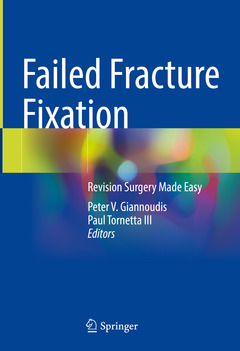Failed Fracture Fixation (2nd Ed., 1st ed. 2024) Revision Surgery Made Easy
Coordonnateurs : Giannoudis Peter V., Tornetta III Paul

This first edition text book describes applicable step-wise approaches to successfully manage patients with failed fracture fixation. Cases are presented for a range of anatomical sites focusing on the aetiology of the failure, clinical examination along with the necessary investigations required for the initial patient assessment, pre-operative planning and its successful execution. Emphasis is placed on detailing when the timing of an intervention is required. A "tips and tricks" section is provided in each chapter enabling the reader to familiarize themselves with potential pitfalls associated with each technique covered and further develop their understanding of the content covered.
Failed Fracture Fixation: Revision Surgery Made Easy is a comprehensive practically applicable guide to understand the aetiology of failure and to become familiar on how to use a range of relevant surgical techniques in a variety of anatomical sites to provide the patient with optimum conditions for a successful clinical and functional outcome. Therefore, it is an essential resource for trainee and practicing orthopedic surgeons seeking up-to-date guidance on how to apply the latest methodologies into their daily practice.
Professor Peter Giannoudis is the Professor of Trauma & Orthopaedic Surgery (tenured post) at the Medical School of the University of Leeds, UK, where he currently continues to work as the chairman of the Department. He is a Fellow of the American College of Surgeons (FACS), a Fellow of the Royal College of Surgeons and Physicians of Glasgow (FRCS (Glasg)) and a Fellow of the Royal College of Surgeons of England (FRCS (Eng)). Throughout his career he has served in positions of responsibility including amongst others: President of the British Trauma Society (2003-2007), President of the European Society of Pelvis and Acetabulum (2007-2012), President of the European Society Tissue Regeneration in Orthopaedics and Traumatology (2018-onwards), Chair of the International Committee of Orthopaedic Trauma Association (USA) (2012-2018), Trustee of the British Orthopaedic Association (2017-2020), and Editor in Chief of Injury Journal (2009-onwards). His research portfolio is broad including the immune inflammatory response to trauma, surgical techniques, tissue regeneration, bioengineering and clinical outcomes.
Dr. Paul Tornetta is Chief and Chair, Professor and Residency Program Director in the Department of Orthopaedic Surgery at Boston University School of Medicine and the Director of Orthopaedic Trauma for the Boston Medical Center. He has served many roles for national and international orthopaedic associations. He has been the chair of multiple committees, served on the board, was Chair of the Council on Education for the AAOS, is a past president of the OTA and was an American British Canadian (ABC) traveling fellow. He is currently in the Presidential line for the AAOS and his Presidential year will be 2024-2025. He has received numerous awards and honors, including the Orthopaedic Research and Education Foundation clinical research award, Two Kappa Delta Awards, several BUSM Robert E. L
Date de parution : 01-2024
Ouvrage de 479 p.
17.8x25.4 cm



